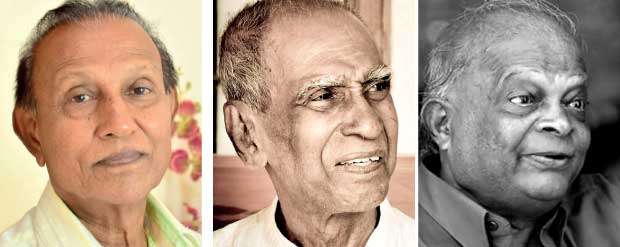Reply To:
Name - Reply Comment
Last Updated : 2024-04-20 09:22:00

 When Jothipala died somewhere in 1987, people wept. His funeral, like the funeral of Rukmani Devi years earlier, was attended by thousands of fans, who braved the soon-to-erupt JVP-UNP bheeshanaya. If we are to assess the worth of a singer on the basis of how prabuddha (highbrow) he is, then there’s nothing to help us rationalise why so many could weep at this particular singer’s funeral. And yet, many did weep. So many, in fact, that after the funeral no less a person than Sarath Amunugama wrote an article on what he termed as the “janapriya sanskruthiya”, where he implied that Jothipala, despite his pandering to populist sentiments, had emerged as a singer of the nation. Having read this essay, Nalin de Silva, by his own admission an admirer of the “prabuddha sanksruthiya” back then, wrote a reply demeaning Amunugama’s stance and explicitly batting for the culture that was opposed to these populist sentiments. Decades later, having repented and turned around as the face of the Jathika Chinthanaya, de Silva eschewed his fascination with the highbrow culture and penned the following: “When Jothipala died, thousands of fans flocked to Kanatte and no ‘prabhuddha’ artiste had ever been respected by so many people at his/her funeral.” It took no less a figure than Amaradeva, the de facto symbol of that prabuddha sensibility here, to compel the same outflow of grief at his passing away.
When Jothipala died somewhere in 1987, people wept. His funeral, like the funeral of Rukmani Devi years earlier, was attended by thousands of fans, who braved the soon-to-erupt JVP-UNP bheeshanaya. If we are to assess the worth of a singer on the basis of how prabuddha (highbrow) he is, then there’s nothing to help us rationalise why so many could weep at this particular singer’s funeral. And yet, many did weep. So many, in fact, that after the funeral no less a person than Sarath Amunugama wrote an article on what he termed as the “janapriya sanskruthiya”, where he implied that Jothipala, despite his pandering to populist sentiments, had emerged as a singer of the nation. Having read this essay, Nalin de Silva, by his own admission an admirer of the “prabuddha sanksruthiya” back then, wrote a reply demeaning Amunugama’s stance and explicitly batting for the culture that was opposed to these populist sentiments. Decades later, having repented and turned around as the face of the Jathika Chinthanaya, de Silva eschewed his fascination with the highbrow culture and penned the following: “When Jothipala died, thousands of fans flocked to Kanatte and no ‘prabhuddha’ artiste had ever been respected by so many people at his/her funeral.” It took no less a figure than Amaradeva, the de facto symbol of that prabuddha sensibility here, to compel the same outflow of grief at his passing away.
The novels of Martin Wickramasinghe, the songs of Amaradeva, and the films of Lester James Peries belong squarely to the first and second of these movements
Clement Greenberg’s analysis of art and non art doesn’t hold much water in Sri Lanka because, as with all colonial societies, we never made the transition from art to kitsch through an intermediate stage; we just transited from the one to the other. As such, instead of art and kitsch, we have what we can broadly term as “jana” on the one hand and “janapriya” on the other. Both these cultural sensibilities, as I wrote last week, neglected the folk culture, the culture regenerated by the efforts of Lionel and Sahan Ranwala as well as the likes of Piyasiri Wijeratne and Rohana Baddage. Rationalising this split requires an explication of how, and why, jana and janapriya remain wedded to each other, as strands of one holistic sensibility, and how and why the folk culture, when it evolved into the formal culture, had to waste away half its essence to the dust in a bid to appeal to mass or elite audiences. Was it because of the fact, which holds valid in virtually every society, that once you attempt to preserve folk art forms through a process of refinement, you inevitably contort those same art forms? And if so, does that explain why Jothipala and Amaradeva occupy the same pedestal, though from opposite ends?
The art forms which evolved after 1956 were smeared, necessarily, by the three art movements the Western world brought out in the 20th century: realism and naturalism, modernism, and postmodernism. The novels of Martin Wickramasinghe, the songs of Amaradeva, and the films of Lester James Peries belong squarely to the first and second of these movements. Out of these pioneers only Martin Wickramasinghe tried to go beyond their confines and parameters, and while Bawatharanaya (his last) is considered a lesser work, as a blatant act of depicting the Buddha the same way Nikos Kazantzakis depicted Christ (‘The Last Temptation’ was published around the time Wickramasinghe was writing Viragaya), it nevertheless attempted to go beyond the limits of modernism. In as much as these artistes discovered a way through which the folk culture could be communicated to lay audiences, they ended up forming a substantial fan base among the milieu aspiring to become a petty bourgeoisie: as a result of free education and the social mobility it enabled among this milieu, the patrons of the Amaradevas and the Perieses and the Chitrasenas came from a bilingual, half-sophisticated crowd. Preservation of the folk culture, at the hands of this crowd, required Westernisation and Sanskritisation.
In the early days, it was the offspring of these lackeys who idealised the folk culture, the peasantry, and tried their hand at preserving folk art forms no matter how imperfect their attempts were. Devar Surya Sena, formerly Herbert Charles Jacob Peiris, son of Sir James Peiris (the first non-European to be appointed President of the Cambridge Union), was the first of these offspring. They came from the Anglican elite, and in their efforts at spawning a national consciousness, they found a meaning for their own uprooted lives.
The generation of Amaradeva and Chitrasena came from a more intermediate social milieu, which belonged at once to both the formal and the folk and yet was at home with neither. They were affluent, but not affluent enough to rake up the sort of leisure and privilege essential for the formation of a refined cultural sensibility. The groundwork laid down by the likes of Sena proved to be crucial to them, and what they had discovered, the petty bourgeoisie added to. But what Sena and Rajapakse lacked, as their recordings of songs we mistakenly allude to as Sinhalese and Buddhist today (“Danno Budunge”) indicate, was the requisite Sinhala-ness to strike a chord with popular audiences. The petty bourgeoisie, at once linked to and disdainful of the peasantry, found their icons with a set of artists who could leap over this limitation. They could not go back to the village, nor could they completely turn away from it. This at times contradictory streak is what makes up much of our cultural revolution, from the 1940s and 50s onwards.

Add comment
Comments will be edited (grammar, spelling and slang) and authorized at the discretion of Daily Mirror online. The website also has the right not to publish selected comments.
Reply To:
Name - Reply Comment
On March 26, a couple arriving from Thailand was arrested with 88 live animal
According to villagers from Naula-Moragolla out of 105 families 80 can afford
Is the situation in Sri Lanka so grim that locals harbour hope that they coul
A recent post on social media revealed that three purple-faced langurs near t